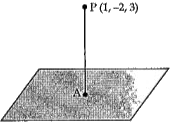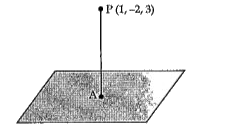Consider a plane π:→r⋅→n=d (where →n is not a unti vector). There are two points A(→a) and B(→b) lying on the same side of the plane.
Q. If a plane π1 is drawn from the point A(→a) and another plane π2 is drawn point B(→b) parallel to π, then the distance between the planes π1andπ2 is :
∣∣(→a−→b)⋅→n∣∣|→n|
∣∣(→a−→b)⋅→n∣∣
∣∣(→a−→b)×→n∣∣
∣∣(→a−→b)×→n∣∣|→n|
The correct Answer is:A
Topper's Solved these Questions
- VECTOR & 3DIMENSIONAL GEOMETRYBook:VIKAS GUPTA (BLACK BOOK)Chapter:VECTOR & 3DIMENSIONAL GEOMETRYExercise:Exercise-4 : Matching Type Problems
Explore 1 Video
- VECTOR & 3DIMENSIONAL GEOMETRYBook:VIKAS GUPTA (BLACK BOOK)Chapter:VECTOR & 3DIMENSIONAL GEOMETRYExercise:Exercise-5 : Subjective Type Problems
Explore 18 Videos
- VECTOR & 3DIMENSIONAL GEOMETRYBook:VIKAS GUPTA (BLACK BOOK)Chapter:VECTOR & 3DIMENSIONAL GEOMETRYExercise:Exercise-2 : One or More than One Answer is/are Correct
Explore 21 Videos
- TRIGONOMETRIC EQUATIONS Book:VIKAS GUPTA (BLACK BOOK)Chapter:TRIGONOMETRIC EQUATIONS Exercise:Exercise-5 : Subjective Type Problems
Explore 9 Videos
Similar Questions
Consider a plane π:→r⋅→n=d (where →n is not a unti vector). There are two points A(→a) and B(→b) lying on the same side of the plane.
Q. Reflection of A(→a) in the plane π has the position vector :
View SolutionConsider a plane π:→r⋅→n=d (where →n is not a unti vector). There are two points A(→a) and B(→b) lying on the same side of the plane.
Q. If foot of perpendicular from A and B to the plane π are P and Q respectively, then length of PQ be :
View Solution
Knowledge Check
Consider a plane π:→r⋅→n=d (where →n is not a unti vector). There are two points A(→a) and B(→b) lying on the same side of the plane.
Q. Reflection of A(→a) in the plane π has the position vector :A→a+2(→n)2(d−→a⋅→n)→nB→a−1(→n)2(d−→a⋅→n)→nC→a+2(→n)2(d+→a⋅→n)→nD→a+2(→n)2→nConsider a plane π:→r⋅→n=d (where →n is not a unti vector). There are two points A(→a) and B(→b) lying on the same side of the plane.
Q. If foot of perpendicular from A and B to the plane π are P and Q respectively, then length of PQ be :A∣∣(→b−→a)⋅→n∣∣|→n|B∣∣(→b−→a)⋅→n∣∣C∣∣(→b−→a)×→n∣∣|→n|D∣∣(→b−→a)×→n∣∣Distance of point P(→P) from the plane →r.→n=0 is
A|→p.→n|B|→p×→n||→n|C|→p.→n||→n|Dnone of these
Consider a plane π:→r⋅→n=d (where →n is not a unti vector). There are two points A(→a) and B(→b) lying on the same side of the plane.
Q. If foot of perpendicular from A and B to the plane π are P and Q respectively, then length of PQ be :
View SolutionConsider a plane π:→r⋅→n=d (where →n is not a unti vector). There are two points A(→a) and B(→b) lying on the same side of the plane.
Q. If foot of perpendicular from A and B to the plane π are P and Q respectively, then length of PQ be :
View SolutionDistance of point P(→P) from the plane →r.→n=0 is
View SolutionConsider the plane π1:2x−3y+4z+9=0 and the point P(1,-2,3).

Distance between π1 and P is _______ units.
View SolutionConsider the plane π1:2x−3y+4z+9=0 and the point P(1,-2,3). π2 is a plane parallel to π1 and containing the point P.

Equation of π2 is _________.
View Solution
